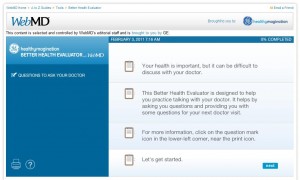“Despite the fading of paternalism and the awakening of patient autonomy, there is a power imbalance between physicians and patients, with patients sensing their own weakness. This imbalance often leads to the patient’s being afraid to speak up about important concerns that should be brought out and discussed. Thus, interpersonal communication is the key area in which doctors and patients should resolve to improve this year.”
The above excerpt is from an article about how better communication leads to better care. The article plays out a scenario where both the doctor and patient learn to speak up and to listen.
That’s no small thing for either party. Doctors are in a rush and are paid only so much for visits. Patients feel the time crunch and are vulnerable, both physically — they’re disrobed, after all — and emotionally. Throw into the mix the language and knowledge barriers, and you have what a former boss called “a spider’s nightmare.”
Companies can help patients — their employees — untangle the web. They can give them the means and the confidence to become engaged, empowered patients and ask smart questions.
Using downloadable checklists
There are many different techniques that could work. The trick is to know your audience and to provide them with flexible solutions that scale up or down based on knowledge and needs.
For starters, companies can host downloadable checklists on their benefits websites. These checklists can cover questions related to general health (how do I lower my BMI? How often should I see you?) or they can be condition-related (now that I have Type 1 diabetes, what do I need to know and do differently?).
This simple tool ensures that employees know the questions to ask and gives them a place to take notes. Companies can create their own tool or leverage existing ones, like this broad, generic one from the American Heart Association. Many public health sites, such as the Mayo Clinic, also offer suggested questions to ask that are grouped by health concern or condition. The benefit to creating one’s own tool is that it offers companies another opportunity to educate employees about the way their medical plans or other benefits work.
WebMD and GE demonstrate a more sophisticated, interactive approach with their Better Health Evaluator. The tool helps employees prepare for a visit to their health care provider by asking the employee a battery of questions.
 Comfortable asking questions
Comfortable asking questions
Right now, it’s fairly basic. It asks for BMI, cholesterol and blood pressure information. It also asks about general physical activity and family history. From this, it generates a report for the patient and the doctor, as well as the recommended list of questions. Patients can see the questions list grow as they answer the survey questions.
The evaluator is accessed via GE’s Healthymagination site. It’s also tucked deep within WebMD. I’m surprised they don’t offer a widget so that others can put the tool on their own site. GE and WebMD have plans to create more of these evaluators, and I’d be interested in kicking the tires on them.
Of course, an app or a more expansive mobile-ready site would be useful for those with smart phones. Most insurers’ mobile-ready sites offer ways to find providers, cost out pharmaceuticals and get urgent care. Unfortunately, they don’t supply tools. It seems a natural to add tools and other aids to these sites. I’d be interested to hear of any company with a mobile-ready site that offers checklists or other support tools. I currently don’t know of any.
To be a confident health care consumer, one must feel comfortable about asking questions and capable of making sound, informed decisions. One needs to know the options and alternatives, dangers and risks. Our health care system isn’t equipping patients to take care of themselves, so companies need to step into the void. Employees are looking to them to do so.
Update (2.7.11): Dr. Howard Luks (@hjluks) and i spoke about this post. After reading it, he pulled together advice and a list of questions for new patients.
This was originally published on Fran Melmed’s Free-Range Communication blog.
